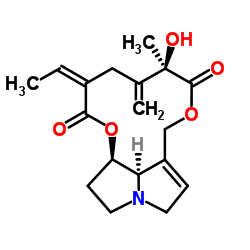Seneciphylline

Seneciphylline structure
|
Common Name | Seneciphylline | ||
|---|---|---|---|---|
| CAS Number | 480-81-9 | Molecular Weight | 333.379 | |
| Density | 1.3±0.1 g/cm3 | Boiling Point | 577.7±50.0 °C at 760 mmHg | |
| Molecular Formula | C18H23NO5 | Melting Point | 217ºC | |
| MSDS | Chinese USA | Flash Point | 303.2±30.1 °C | |
| Symbol |

GHS06 |
Signal Word | Danger | |
Use of SeneciphyllineSeneciphylline is a toxic pyrrolizidine alkaloid in Senecio plants[1]. Seneciphylline significantly increases the activities of epoxide hydrase and glutathione-S-transferase but causes reduction of cytochrome P-450 and related monooxygenase activities[2]. |
| Name | Seneciphylline |
|---|---|
| Synonym | More Synonyms |
| Description | Seneciphylline is a toxic pyrrolizidine alkaloid in Senecio plants[1]. Seneciphylline significantly increases the activities of epoxide hydrase and glutathione-S-transferase but causes reduction of cytochrome P-450 and related monooxygenase activities[2]. |
|---|---|
| Related Catalog | |
| References |
| Density | 1.3±0.1 g/cm3 |
|---|---|
| Boiling Point | 577.7±50.0 °C at 760 mmHg |
| Melting Point | 217ºC |
| Molecular Formula | C18H23NO5 |
| Molecular Weight | 333.379 |
| Flash Point | 303.2±30.1 °C |
| Exact Mass | 333.157623 |
| PSA | 76.07000 |
| LogP | 0.81 |
| Vapour Pressure | 0.0±3.6 mmHg at 25°C |
| Index of Refraction | 1.581 |
| Storage condition | 2-8℃ |
CHEMICAL IDENTIFICATION
HEALTH HAZARD DATAACUTE TOXICITY DATA
MUTATION DATA
|
| Symbol |

GHS06 |
|---|---|
| Signal Word | Danger |
| Hazard Statements | H301 |
| Precautionary Statements | Missing Phrase - N15.00950417 |
| Hazard Codes | T |
| Risk Phrases | R23/24/25 |
| Safety Phrases | 1-20-24/25-45 |
| RIDADR | UN 1544 |
| Packaging Group | III |
| Hazard Class | 6.1(b) |
|
Interplant alkaloid variation and Senecio vernalis toxicity in cattle.
Vet. Hum. Toxicol. 43(3) , 147-51, (2001) Senecio vernalis and other plants containing pyrrolizidine alkaloids (PA) are implicated in the poisoning of cattle. The liver is a known target organ. In this study the content of the alkaloids senec... |
|
|
Pyrrolizidine alkaloids in pollen and pollen products.
Mol. Nutr. Food. Res. 54(2) , 292-300, (2010) Recently, 1,2-dehydropyrrolizidine alkaloid (PA) ester alkaloids, found predominantly as their N-oxides (PANOs, pyrrolizidine N-oxides), have been reported in both honey and in pollen obtained directl... |
|
|
Mutagenic activity of the pyrrolizidine alkaloids seneciphylline and senkirkine in Drosophila and their transfer into rat milk.
Food Chem. Toxicol. 22(3) , 223-5, (1984) Seneciphylline and senkirkine, two pyrrolizidine alkaloids that occur in animal feeds and medicinal herbs, respectively, have been tested for their ability to produce sex-linked recessive lethals in m... |
| (3Z,6R,14aR,14bR)-3-Ethylidene-6-hydroxy-6-methyl-5-methylene-3,4,5,6,9,11,13,14,14a,14b-decahydro[1,6]dioxacyclododecino[2,3,4-gh]pyrrolizine-2,7-dione |
| Jacodine |
| [1,6]Dioxacyclododecino[2,3,4-gh]pyrrolizine-2,7-dione, 3-ethylidene-3,4,5,6,9,11,13,14,14a,14b-decahydro-6-hydroxy-6-methyl-5-methylene-, (3Z,6R,14aR,14bR)- |
| a-Longilobine |
| α-Longilobine |
| (15Z)-12-Hydroxy-13,19-didehydrosenecionan-11,16-dione |
| seneciphylline |
| (3Z,6R,14aR,14bR)-3-Ethyliden-6-hydroxy-6-methyl-5-methylen-3,4,5,6,9,11,13,14,14a,14b-decahydro[1,6]dioxacyclododecino[2,3,4-gh]pyrrolizin-2,7-dion |
| (3Z,6R,14aR,14bR)-3-éthylidène-6-hydroxy-6-méthyl-5-méthylène-3,4,5,6,9,11,13,14,14a,14b-décahydro[1,6]dioxacyclododécino[2,3,4-gh]pyrrolizine-2,7-dione |

